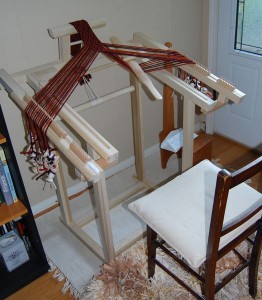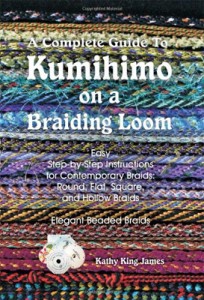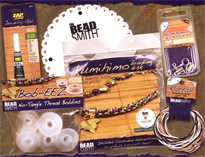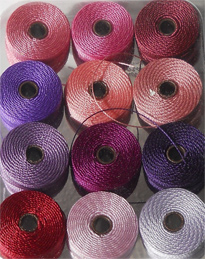for recommended book at Amazon (click here)
Kumihimo is a braiding technique that is used in the making of long decorative strands. These cords are used in a variety of decorative ways. Some people wear them as bracelets or necklaces. Others use them as functional laces or simply let them swing free. Basic strands are made by looping thread through the fingers in a repetitive manner. Ancient samurai warriors used to decorate their armor and sometimes hold it together using kumihimo cords. Kumohimo is a fun and colorful part of Japanese heritage.
The first kumihimo were made entirely by hand. These cords were strong but very visually simple. To meet high commercial demand for unique cords, Kumihimo techniques evolved to a degree that necessitated the use of large wooden stands that resembled the looms used to weave cloth. These stands sped up the process of making thick, colorful strands. Kumihimo became an integral part of traditional Japanese dress.
These days, simple kumihimo braids are made by affixing thread of different colors to different points around a disk that is made expressly for this purpose. Complex cords can be made using up to 24 different pieces of thread. There is no right way to make kumihimo. Each cord is comprised of threads of varying colors and thicknesses. Some look like uniform braids and others look like series of well-placed knots. Some people have turned their kumihimo hobbies into luxury fashion trades. They make their cords out of strands of silk and other expensive materials.
The literal meaning of the word kumihimo is “come together.” The name suits the braids, which are painstakingly connected by their makers. Designs do not appear in kumihimo by chance. Expert braiders have learned how to place their pieces of thread around their tools to create the patterns they desire. With experience, kumihimo enthusiasts develop braiding techniques that are so complex as to border on engineering. They swap colors and thicknesses around in the midst of making single cords to deliberately disrupt their carefully planned patterns.
Traditional Takadai, frame used for making kumihimo (by Claire Cassan cc)
Kumihimo braids are very similar to the friendship bracelets that young girls often make for each other out of embroidery floss or thick strands of rubbery plastic. The simplest looping techniques involve four or five threads that are looped through each other to create the appearance of slanted stripes in alternating colors. The threads can be knotted in opposing directions that meet in the middle to make a V shape. The same alternating knotting process can be tweaked to result in intricate lattice patterns. Distinct images can be embedded or embroidered into the fabric of a flat kumihimo. If the threads are pulled overly tight at specific intervals, the cords can be molded into curved shapes with sculpted borders. Few American crafters progress beyond basic loop or box patterns when making their handmade jewelry, but kumihimo is a flourishing, significant industry in Japan. Context transforms an inconsequential summer camp pastime into something that is taken quite seriously in Japan.

Kumihimo disks are made out of flexible plastic or hardened foam. They are usually about six inches in diameter and have up to 24 slots placed evenly around their entire circumferences. The kumihimo hangs downward through a hole in the disk. The threads are detached from their secure slots when they are being used to make knots and placed in new slots when they need to be held taut. These disks are great for beginners because they keep all of the threads organized and separate on an even viewing field. The cord is kept out of the way as it grows longer. The cords that are made on disks are round and have even patterns.
Kumihimo Disk & Plate
Disks are not suitable for experienced braiders who want to make cords that would be too thick to fit through the central hole in a begginer’s disk. A maru dai is a wooden apparatus that looks like a miniature stool. A braider can hone the skills she learned from her disk on a maru dai. A maru dai stands up on its own, freeing up the braider’s hands to create intricate patterns without worrying about also keeping a disk steady. It does not have slots to hold threads in place, instead relying on weighted bobbins to provide the necessary tension. The braider can use as many threads she wants in whichever formations she chooses, since she will not be limited by evenly placed slots like the ones on a disk. A maru dai will help a braider graduate from round cords to flat graphic ones.

The kaku dai is an inverted maru dai. The finished expanse of the cord is held upward on a stand, and the weight of the hanging bobbins keep everything secure. One type of loom is a karakumidai, which takes a long time to master. The braider needs to learn how to maintain a delicate balance of tension. This tension is more important than the braiding technique when this tool is being used.
Starter kumihimo kits are available from multiple online retailers for under $20. A kit usually includes a disk, a brief instruction manual and enough thread to make a few cords.
The tools used to make kumihimo become more complicated and difficult to use in accordance with the complexity of the designs that the braider would like to create. The largest looms that require the most skill to operate produce kumihimo cords that are so thick and ornate that they resemble slender strands of woven fabric. Authentic maru dai stands can be a little difficult to acquire. They are only sold by specialty merchants and cost over $100. A maru dai may be delivered in pieces that the braider has to assemble herself. She will have to do research regarding complex braiding techniques, since they are beyond the scope of booklet from a starter set. Many kumihimo enthusiasts have uploaded videos demonstrating how to do basic knots on a maru dai. A creative braider will probably enjoy being left to her own devices when inventing her own techniques.
for recommended book at Amazon (click here)


